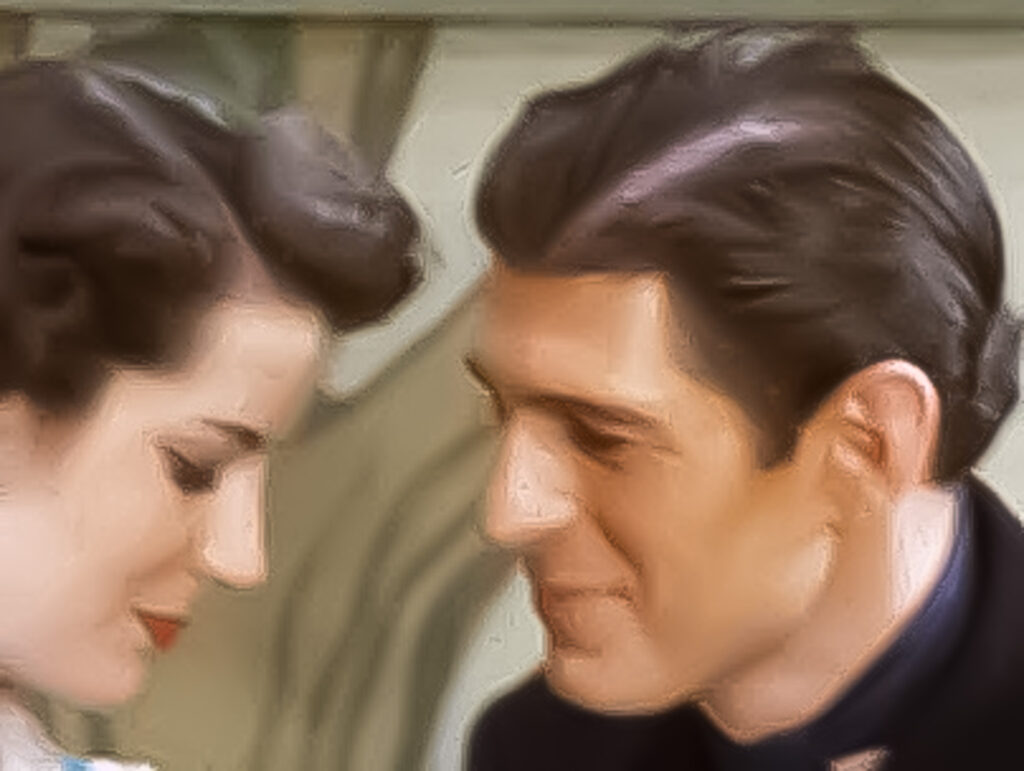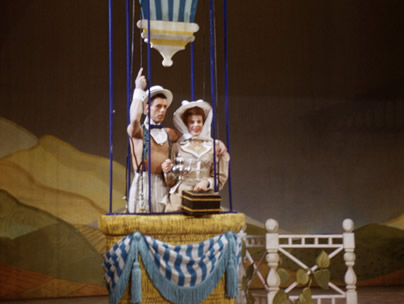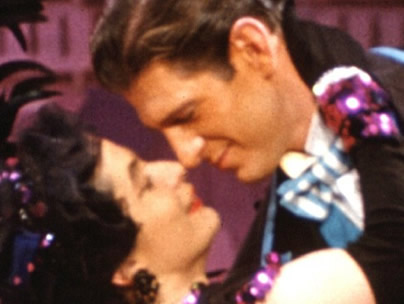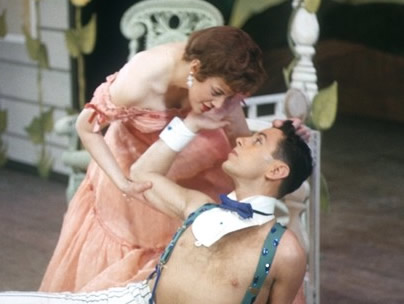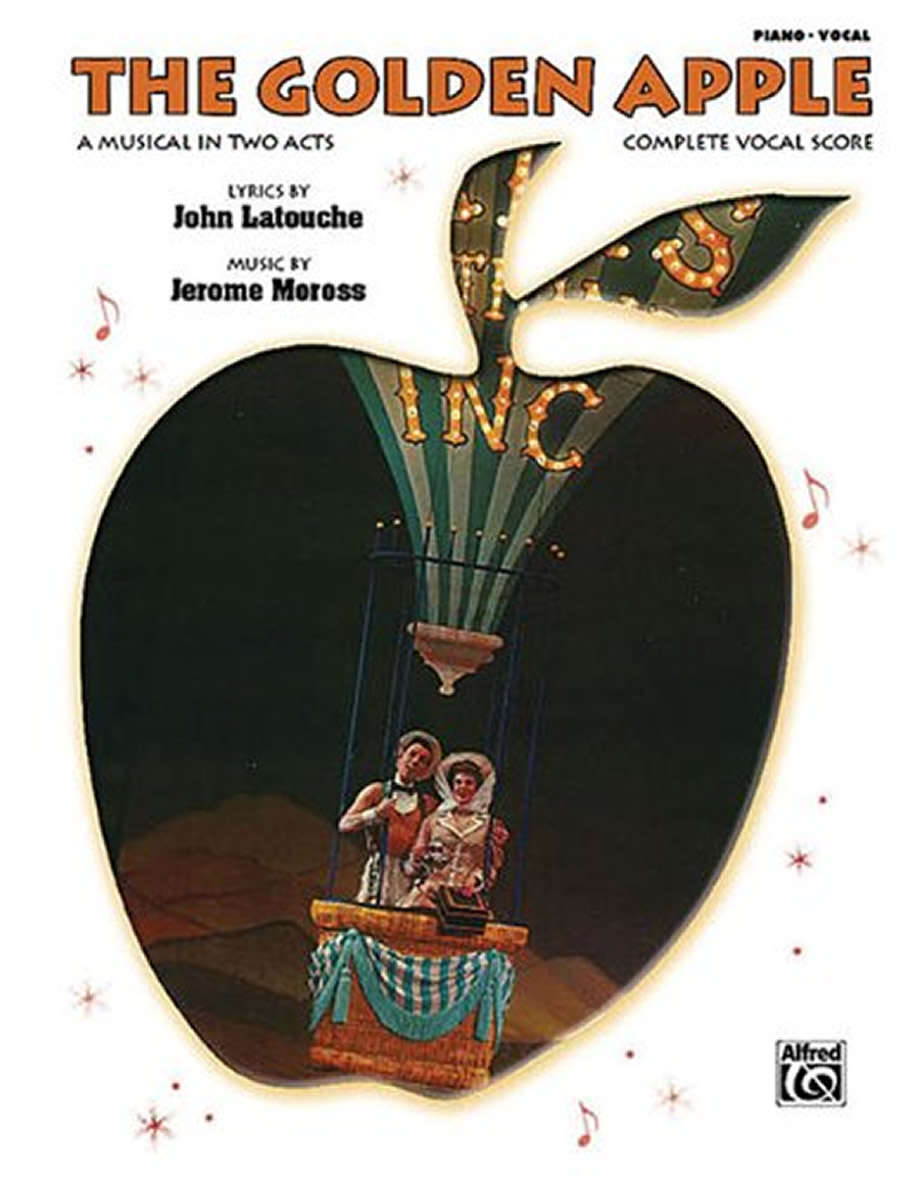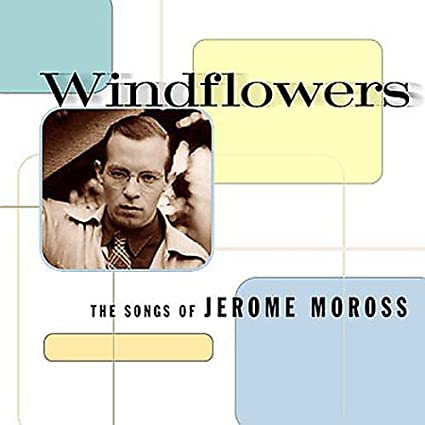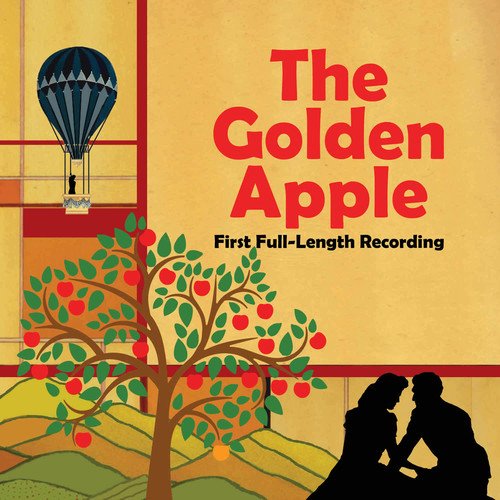THE GOLDEN APPLE
THE SHOW
GETTING TO THE CORE OF THE GOLDEN APPLE
It’s one of those musicals everybody knows is good but nobody knows. With The Golden Apple, librettist John Latouche and composer Jerome ‘Moross virtually invented a new musico-dramatic form. This delightful show, best described as a “musical comedy opera,” offers a consistently surprising and enchanting collection of contradictions. Based on Homer’s epic poems, The Iliad and The Odyssey, it presents classical Greek myth as accessible American folklore. It combines satire and sentiment, one-liner jokes and three-dimensional characters, giddy fun and genuine ideas, all in a commercial entertainment that is also a work of art. Both a musical comedy without dialogue and an opera without operatic music, it is as capable of pleasing the tired businessman as it is the Sondheim acolyte. A recognized theatrical milestone dating from 1954, it has had little practical effect on the evolution of the musical, and yet the very form it pioneered is now the dominant commercial form of musical theatre.
The Golden Apple was the first off-Broadway musical to transfer commercially to the Great White Way. Nonetheless, the critical huzzahs it received (including the prestigious Drama Critics Circle Award) didn’t prevent its run at the Alvin Theatre from lasting a disappointing 16 weeks. The Random House libretto has long been relegated to rare book stores and the occasional library. Neither vocal selections nor a full score were ever published. The out-of-print RCA cast album (reissued briefly on Elektra Records in the 1960s) has never been released on CD. If one can find a copy, the severely truncated (to fit on one LP) recording, while certainly providing a tantalizing taste of this startling piece, fails utterly to convey the exhilarating way in which the show works as an entity (and is additionally handicapped by the annoying rhymed narration added at the eleventh hour to bridge the plot gaps). Considering all the obstacles, it’s a wonder that the show has any contemporary profile.
And yet, The Golden Apple remains stubbornly alive. Off-Broadway, four revivals have appeared: Equity Library Theatre (1961), its commercial version (1962) and two York Theatre Company productions (1978 and 1990). A one-hour version was broadcast in 1977 on the CBS Camera Three series, and it was announced as a major Broadway revival (1972) and as a Town Hall concert (1977), although neither actually happened. It had a number of summer stock productions in the wake of its original success and still pops up occasionally at an adventurous theatre. Most recently, Light Opera Works of Evanston, Illinois, in conjunction with Chicago’s Pegasus Players, presented it in August 8, 1995. This production featured William and Jean Eckart’s much lauded original scenic concept and employed, for the first time professionally since 1954, the full 25 piece Hershey Kay/Jerome Moross orchestration.
In commercial terms, The Golden Apple has always been a hard sell. The idea of a through-composed, all-rhyming musical version of Homer’s intimidating classic set in turn-of-the-century, small town America was Greek to the ears of a host of skeptical would-be producers. Though librettist John Latouche cajoled Cheryl Crawford into sponsoring his and Moross’ successful application for a Guggenheim grant to write it, the finished product scared her away. From Kermit Bloomgarden to the Theatre Guild, top producers toyed with it and then dropped it.
Finally, it was presented off-Broadway by the newly created Phoenix Theatre in an old Yiddish vaudeville house at Second Avenue and 12th Street. The Phoenix was modeled on one of London’s first “fringe” theatres, the Lyric Hammersmith, where “recognized artists” in challenging work were offered at low prices. In the early 1950s, off-Broadway served largely as a bare-bones showcase for unknown talent. The Phoenix set out to change that. The triumphant finale to their first season, The Golden Apple established the company as a force to be reckoned with in New York theatre.
But the commercial transfer didn’t take. One handicap was Brooks Atkinson’s review in The New York Times, which caviled about the sung-through nature of the show. Atkinson liked much of what he saw, but he wanted “songs” and apparently lacked the ear to find The Golden Apple’s plentiful supply of them, even calling “Lazy Afternoon,” the one standard to come out of the score, “bland.” The rest of the virtually unanimous rave notices found no such problem.
Still, audiences probably sensed an unfortunate strain of elitism. The critics went out of their way to mention that the show was fun! fun! Fun! and that knowledge of the original Homeric texts wasn’t necessary to enjoy it. That was true. Unfortunately, such vociferous insistence implied that if you were conversant with Homer, you’d enjoy The Golden Apple all the more. One does not entice the mass audience into the theatre by promising them they’ll be made to feel ignorant. The cognoscenti flocked and the masses went to The Pajama Game.
But The Golden Apple really is an unpretentious and accessible delight. Resetting the familiar legend of Paris’ abduction of beautiful Helen, whose face launched a thousand ships to the Trojan War, in the turn-of-the-century American West, it finds specific, recognizable American archetypes to tell its classic tale. Homer’s original is an adventure story of war, full of battles and heroism, not to mention monsters and other supernatural villains. Its hero, Ulysses, is punished for his arrogance in believing that power is man’s right and that man can control his fate in the face of a hostile and capricious universe, dominated by mysterious forces which are personified by the gods of Greek mythology.
The Golden Apple shifts the focus of the tale from adventure to satire in what is both a celebration and criticism of the American character. The transposition of high-flown Greek myth to folksy American settings is inherently humorous. John Latouche described his work as “no adaptation of Homeric grandeurs, but a comic reflection of classical influence on the way we think nowadays.” But it also contains a strong emotional core by accentuating the character of Penelope, the wife Ulysses leaves behind, and her yearning for her husband to cease adventuring and pay attention to the human values of home and hearth. Latouche’s focus is not on battles and adventures but, rather, Ulysses’ “search for a set of stable values in the frenetic process of change.”
The capriciousness of the gods becomes the incredible scientific progress of the 20th century, which will eventually temper the innocent, naive, unthinking optimism of Teddy Roosevelt’s America. Written less than a decade after Hiroshima and Nagasaki, The Golden Apple employs the lightest of touches and the vocabulary of that most American art form, the musical comedy, to suggest the need for maturation of the American manifest destiny mindset.
Latouche was determined that it would all “arise out of our native songs, dances, jokes and ideas,” not only because of its American setting, but because he believed that “a truly lyric work is direct, open and entertaining.” The sparklingly melodic and rhythmically infectious Jerome Moross music makes great use of “popular songs and dances of the period – waltzes, ragtime, blues, vaudeville turns, etc.,” all filtered through a distinctly original contemporary voice. Moross’ personal musical vocabulary had always been rooted in American folk music, which he then combined with more sophisticated harmonies, rhythms and classical structures, making him the ideal composer for The Golden Apple. Setting out to write a score that was “constructed as a series of interlocking musical comedy production numbers,” he and Latouche hoped “that those who wanted to be entertained could come and have an evening of just fun” but that at least some might enjoy “the comment woven into the work.” “We hope it pleases and at the same time we hope it stimulates,” they told The New York Times.
To the consternation and delight of disparate audiences, they succeeded. The consistently witty, gently satiric humor, the genuinely touching simplicity of sentiment, the imaginative and colorful methods of theatrical presentation, and the adroit updating of classical myth allowed The Golden Apple to effortlessly commingle art and entertainment without ever sacrificing one to the other. Whether playing to the intellectual, dramatic play Phoenix Theatre crowd or the more broad-based Broadway musical fans, the house was always happy.
The show underwent very little change in its novel off-Broadway tryout. The insulation from commercial pressures allowed Latouche and Moross’ vision to remain nearly intact. Director Norman Lloyd, a man who had little experience with musicals, did not share the vision of the creative team and left late in rehearsal. Producer Alfred de Liagre took over working with the actors. Meanwhile, choreographer Hanya Holm and William and Jean Eckart made the set, which was a series of light, airy framed pieces and cut-outs made of folding panels of fabric (suggested by shoji screens), work fluidly with the staging in a way that would eventually become routine in musicals, but was still new at the time.
The only major disagreement to cause real dissension in the creative ranks involved the finale. Originally, the show ended with a duet for the reunited Ulysses and Penelope, “We’ve Just Begun,” a soaring hymn of middle-aged hope. This was considered a letdown by several critics, who wanted a more “rousing” finale. Latouche and Moross tried to deal with the objections by drastically rewriting and shortening the final scene leading into the song, while also adding a quick reprise of “Lazy Afternoon” for good measure. But producers de Liagre and Roger Stevens insisted that “you can’t end a musical with only two people on-stage.” Instead, they pressed for a reprise of Ulysses and Penelope’s Act One love song, “It’s the Going Home Together,” backed by a full chorus in the best tradition of Broadway finales.
Unfortunately, this changed the entire meaning of the show. “We’ve Just Begun” was about husband and wife making a new commitment, suggesting that each had learned from his or her mistakes and that they would now start afresh. The reprise suggested that they knew everything they needed to know at the start and were returning to their old relationship. The producers made the change the price of moving uptown and the authors reluctantly paid it. But though this is what was published and recorded, the authors reinstated the original ending as early as the following year in summer stock. “We’ve Just Begun” is now the only ending made available by the show’s licensor, Tams-Witmark.
The Golden Apple shares elements of dramatic approach and thematic concern with other shows of its period. Its skeptical view of the Industrial Revolution and scientific progress was a theme of 1948’s Love Life, and its Act Two sequence of music hall numbers is akin to the minstrel show in which Love Life’s principals sort out their marital problems. 1947’s Allegro pits the corruption of the big city against the innocence of small town American life with more sanctimony, but remarkable similarity. The 1954 film Seven Brides for Seven Brothers was another musical comedy updating of myth set in the frontier American West. And playwrights such as Jean Giradoux (Amphitryon 38 and The Trojan War Will Not Take Place) and Jean Anouilh (Antigone) had already updated classical myths in order to deal with their own contemporary concerns. What made The Golden Apple so unique was neither its themes nor its theatrical devices, but its bold attempt to find a new musico-dramatic form of storytelling. John Latouche (1914-1956) was one of Broadway’s most perpetually promising lyricists. His collaborator Jerome Moross (1913-1983) was a Brooklyn-born, classically trained composer whom Aaron Copland said was “probably the most talented” composer of his generation. In the tradition of Gershwin, Weill and Bernstein, Moross was that Broadway rarity, an excellent tunesmith who could also write for the concert hall and orchestrate his own work. Financial pressures led Moross to Hollywood, and he is best known today for his film scores, particularly for several notable westerns. He also wrote a number of successful ballets, including the classic Frankie and Johnny, as well as numerous concert works.
Although he had a show on Broadway by the age of 21 (the 1935 satirical political revue Parade, produced by the Theatre Guild) and his burning goal was to create a new form of American musical, Moross ended his career with only four musical shows to his credit (plus a one-act opera based on Sorry, Wrong Number, his last major work, completed in 1977). It was a disappointingly slim output, largely due to the fact that Moross sat and waited for Latouche to be available, while Latouche often worked with other composers as well. Once Latouche died, Moross was unable to find as suitable a collaborator. Nevertheless, in their work together, Moross did know the satisfaction of realizing his goal.
The two men had been trying to write something together since they first met in the late 1930s. That something became the experimental music theatre piece, Ballet Ballads, which debuted off-Broadway in 1948 as a production of, quite appropriately, the Experimental Theatre (after losing the sponsorship of the man who commissioned it, impresario Mike Todd). Ballet Ballads was the first crucial step in their search for a new theatrical form, one that could tell tales of mythic size and feel in a stylized way, mixing dance, song and storytelling in equal parts. The show consisted of four “ballads,” one of which, a topsy-turvy version of “Little Red Riding Hood” (which featured a heroine much tougher than the wolf, long before Into the Woods) was dropped before production due to lack of funds. The other three were “Susannah and the Elders: (“a revival meeting”), “Willie the Weeper” (an extended “reefer dream”) and “The Eccentricities of Davy Crockett” (as told by himself). Each had its own choreographer and a rhymed text by Latouche set to music by Moross.
As the title implies, the evening was based in dance. The tales were narrated rather than dramatized, with soloists and/or chorus singing while dancers’ carried out the action. Roles were double cast (“singing Willie” and “dancing Willie,” for example), though sometimes the dancers did their own singing as well. Both in description and critical reaction, the show sounds remarkably similar to Graciela Daniele’s current attempts to find a dance-based theatrical storytelling form (utilizing in her case speech as well as song), most recently on display in Chronicle of a Death Foretold. Ballet Ballads was a succes d’estime. Words like “adventurous, novel, interesting whimsical, unique, unusual” were used by the critics to describe it.
Brooks Atkinson called it “one of the most joyous performances of the season,” but also said “it would be overenthusiastic to describe [it] as a new art form.” There were also a few contrary voices. Those critical of Ballet Ballads had been particularly irked by the equal time given to each artistic discipline. Walter Kerr summed up such complaints when he called the mix of forms distracting, “promising first one thing, then another, without being free to fulfill the promise wholly either way.” The show did attempt a Broadway transfer, but nobody seemed to know if it was a musical or a ballet or a concert, and it wilted at the Music Box in the heat of July after only a nine-week run.
Nonetheless, Latouche and Moross were emboldened by the overwhelmingly positive tone of the response and decided to try again. They also listened to their critics and made a crucial refinement in approach to their new form. As they set about mapping out The Golden Apple, they made a clear choice to tell the story primarily through words and music. This is not to say that dance played no part. The important role of Paris was fashioned as a non-speaking, all-dancing one. There were also several choreographic set pieces, including an Act One welcome home celebration gently spoofing the sturdy rusticity of Rodgers and Hammerstein’s hayrides and clambakes (“We’re Going to Raise a Ruckus Tonight”) and the vaudeville routines of Act Two’s nightmare city sequence. And the scene changes were carefully choreographed. Still, the attempt at equal balances had definitely shifted. Words and music now dramatized, rather than narrated, the story. All other elements now enhanced and supported, rather than competed, with that basic goal.
What made it unique was the retention of the all-sung, all-rhymed structure, the idea of which at the time was a major turnoff to the general public. Rodgers and Hammerstein had made the musical play the ascendant commercial form. Operetta was passé (which Latouche knew from the painful experience of writing lyrics for two of them) and all attempts at opera on Broadway, including such critically acclaimed shows as Porgy and Bess, Regina, Street Scene and The Medium, had failed commercially. Indeed, when Porgy and Bess was revived in 1942, Cheryl Crawford insisted on producing it as a musical play with dialogue, rather than a through-sung opera. It then became a commercial hit.
But The Golden Apple was an “opera” with a difference. Everything in the evening was structured in popular song forms. Even the recitative (i.e., the sung sections between longer songs that carried the dramatic action forward) was structured as miniature songs, often using fragments of melody later expanded upon elsewhere. It wasn’t the dreaded endless repetition of a single note so familiar to habitués of the Metropolitan horseshoe. Nor were the voices traditionally operatic. Such performers as Kaye Ballard, Bibi Osterwald, Portia Nelson and Charlotte Rae (a cast replacement) had been plucked from the world of night clubs. Nola Day came from television and radio. Jack Whiting was an old vaudeville soft shoe man. The more legitimate voices of romantic leads Stephen Douglass and Priscilla Gillette were really just strong musical theatre voices.
Nonetheless, audiences could not be convinced in sufficient numbers to sample this new form. It took the success of Jesus Christ Superstar and Evita in the 1970s to challenge the commercial stranglehold of the book musical. Ironically, it’s unlikely that those shows had any connection to Latouche and Moross’ achievement. Authors Andrew Lloyd Webber and Tim Rice have often stated in interviews that they wrote Superstar in the form of a pop record album because they despaired of getting it produced as a theatre piece. When its success led to a stage production, this inevitably dictated a form where a series of songs combine to tell a story without intervening dialogue, as no one wanted to muck about with what was already a huge hit. The result was as accidental as The Golden Apple was deliberate.
What Lloyd Webber, Boublil and Schönberg and other noisy Europeans now employ for their through-sung efforts is simply a cruder, less intelligent and more bombastic version of what Latouche and Moross pioneered. The musical vocabulary is more European than American, but it is still based in song forms. A particularly noteworthy difference between the two is evident in their texts. Latouche’s rigorous attention to character delineation, coupled with his rich language and endlessly inventive and playful rhymes, allow him to keep The Golden Apple gloriously aloft. They also make the nearly instantaneous switching of tone from satiric to sentimental, deftly mirrored in the music as well, seem effortless and natural. Today’s pop operas, however, are notable for the virtual absence of any humor, while striking a relentless note of plodding portentousness in their simple-minded, cliche-strewn texts (also too often deftly mirrored in the music).
A few American writers have dabbled in this form, notably Marc Blitzstein in The Cradle Will Rock (before Latouche and Moross), Frank Loesser in The Most Happy Fella and William Finn in Falsettos, but it never took commercial root in the Broadway theatre. This is at least in part due to a major pitfall. It becomes much harder for a dramatist to utilize subtext (i.e., the difference between what a character is feeling or thinking and what he or she is saying) when everything is sung. Music, being an abstract medium, is so emotionally persuasive that it usually makes what is being sung sound like it is honestly meant. This reduces the complexity of human character. And Broadway musicals have always been (at least until recently) colloquial and human, unlike opera, where size, grandiosity and the reduced importance of the text work against nuance and detail.
But musicals like the above prove that there are ways around that. Now that the public is eager for through-composed shows, perhaps young writers ought to take a look at how Latouche and Moross did it simpler, smarter and stronger more than 40 years ago. And perhaps an enterprising commercial producer ought to follow the lead of Light Opera Works and Pegasus Players and reinvestigate one of the milestones of American musical theatre. H. L. Mencken said that no one ever went broke underestimating the taste of the American public. But it may just be possible that the American public has finally caught up with The Golden Apple.
THE GOLDEN APPLE:
THE COMPLETE VOCAL SCORE
THE GOLDEN APPLE is a highly acclaimed 1954 Broadway musical based on Homer’s The Iliad and The Odyssey. The score by John Latouche and Jerome Moross has been compared to music from Porgy and Bess and Candide for its opera-like qualities. Experience these marvelous songs with this special edition, which includes favorites such as “It’s the Coming Home Together” and “Lazy Afternoon.”
WINDFLOWERS: THE SONGS OF JEROME MOROSS
WINDFLOWERS offers delectable proof, with selections from his stage shows Ballet Ballads, The Golden Apple, Underworld, and Gentlemen, Be Seated! Alice Ripley, Richard Muenz, Jessica Molaskey, Philip Chaffin and Jenny Giering – five singers equally at home on Broadway, in cabaret and in the recording studio – celebrate an American original, in nineteen selections alternately playful and atmospheric, and always highly melodic.
THE GOLDEN APPLE: THE FIRST COMPLETE RECORDING
When it premiered in 1954, composer Jerome Moross and librettist John Latouche’s THE GOLDEN APPLE was hailed as “the most original musical since Oklahoma!” (The Washington Post), “the best thing that has happened in and to the theatre in a very long time” (New York Daily News), and “a magnificent achievement. A sensational success. The most imaginative work of its kind” (New York Daily Mirror).
